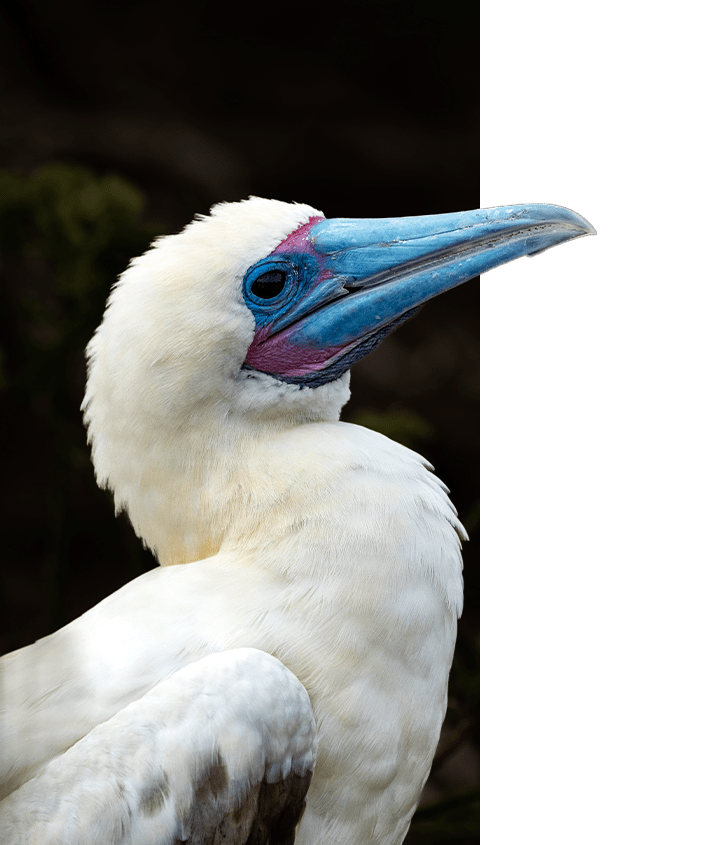
The Galapagos Islands are an animal lover’s paradise and the best place in the world to safely get close to, and even interact with, animals in the wild.
Galapagos is arguably one of the safest and most magical destinations in the world. But what about getting there? Is there anything to be aware of when it comes to safety along the way or once you arrive? This article addresses these questions, focusing mainly on the places you must pass through to get to and from the Galapagos, and less on places farther afield that you may want to visit along the way.
How To Get To Galapagos
So, let’s take a quick look at how to get there. The Galapagos archipelago sits on the equator, six hundred miles (1000km) off the South American coast. The only way to get to the islands is to first fly to the country of Ecuador. There are no direct flights to the islands from any other country and the flights to Galapagos aboard regularly scheduled commercial jets leaving from either Ecuador’s capital of Quito, in the Andes, or its largest city of Guayaquil set along the coast. There are newly added flights from Manta, but most international flights there pass through either Quito or Guayaquil in any case.
There aren’t any cruises or commercial marine vessels that will take you from the South American continent to Galapagos and all cruises aboard vessels permitted to operate in the archipelago begin and end in the Galapagos. For a detailed article, click here - How to Get to the Galapagos Islands
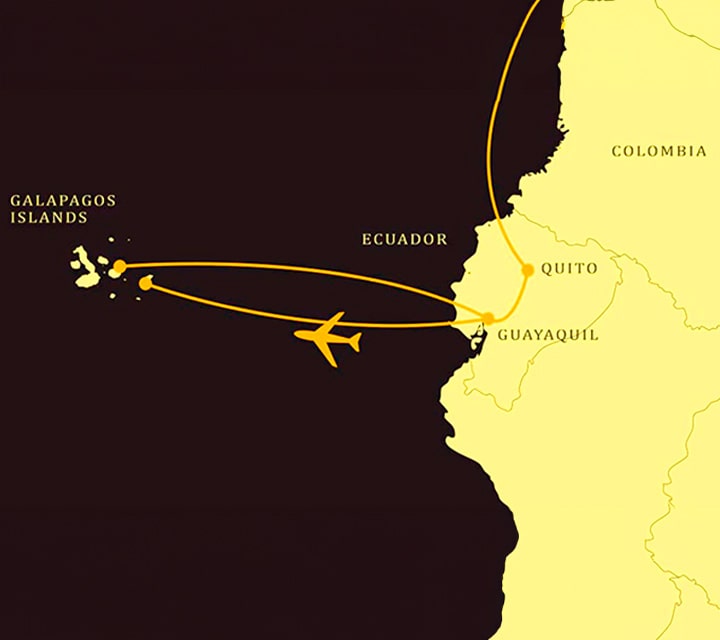
Latest News on Ecuador Safety - May 2024
On April 21st Ecuadorians went to the polls and voted in a series of measures aimed at supporting President Daniel Naboa’s agenda to combat drug violence and increase security throughout the country. The day after the election, the referendum, which passed handily with 71% of the country voting, received a boost when Ecuadorian police announced the arrest of a notorious alleged gang leader.
The US State Department advisory for Ecuador remains at level 2, which is the same as England, France & Germany. However, the advisory continues to warn travelers against spending time in the city of Guayaquil and coastal areas where drug violence has been centered. According to the British Home Office, “this does not apply to air side transit within Guayaquil Airport…including onward or return travel to the Galapagos Islands.” i.e. transiting through Guayaquil airport is safe.
As the US State Department advisory suggests, the parts of Ecuador frequented by tourists, including Galapagos, Amazon and Andean highlands surrounding Quito remain secure and peaceful.
This blog remains relevant to the current situation and we recommend checking the US State Department advisory for updates. We recommend working with a travel operator that truly knows the country as well as how to keep you secure throughout your adventure. A good travel company can arrange all your transfers, hotels and excursions while accompanying you during each part of your adventure. They will know where to go, and where to avoid, while offering a 24/7 support line, so you can enjoy authentic experiences, while keeping safe and secure. Travelers can spend time in the mainland, or just pass through, on the way to Galapagos. That said we advise those who have already booked their arrangements to continue to communicate with their provider and follow the US State Department advisory.
Ecuador Safety Issues
Because you’ll have to fly through mainland Ecuador to get to the Galapagos let’s look at safety issues there.
For starters, it’s not a good idea to expect to arrive in Ecuador and immediately connect to a flight to Galapagos. Not only is this because most international flights from places like North America arrive in Ecuador late at night (while flights to the Galapagos leave in the early part of the day), but you will want to build a buffer day into your itinerary to guard against flight delays. That’s because, once many Galapagos luxury cruises leave you can’t catch up to them because they normally navigate far away from the port towns. Missing your flight to the Galapagos can mean missing your cruise entirely. The best way to guard against this is to plan to fly to mainland Ecuador a couple of days prior to your cruise, which is typically the same day you fly from the mainland to Galapagos. That means spending two nights and one day in mainland Ecuador.
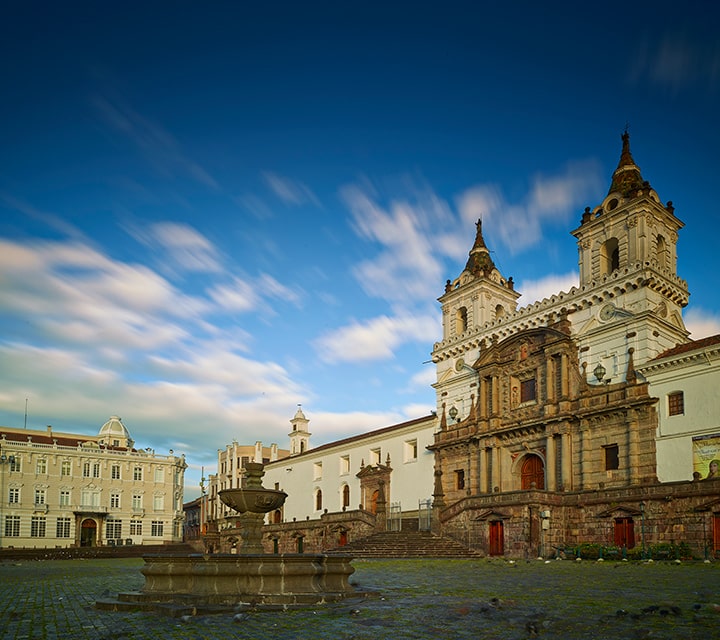
At this writing Ecuador has a US State Department Travel Advisory level of 2 (1 being the safest), which is the same as countries like France, Germany and the United Kingdom and means Exercise Increased Caution. Like any country, there are many inviting places that are safe to visit in Ecuador, while there are others you’ll want to avoid or exercise caution when traveling to.
Quito
The country’s capital sits 9,000 ft above sea level in the Central Andes and is the best place for most international travelers to fly in and out of when visiting the Galapagos. Quito tours are a low risk / high reward destination as there is so much to see and do in and around Quito on the one hand, while on the other, it is largely free of the safety concerns found along the coast.
The main attraction in the city of Quito is the Colonial Section, which was designated as the very first UNESCO Heritage Site. For most travelers there isn’t much reason to stay in this city of 2 million unless you plan to visit the colonial section, in which case it’s most convenient to stay in Colonial Quito. Otherwise, travelers to the Galapagos are likely better off staying by the airport, which sits in a nice section of the Andean Countryside north of the city and an hour from the colonial section, with most of the city lying between these two locations.
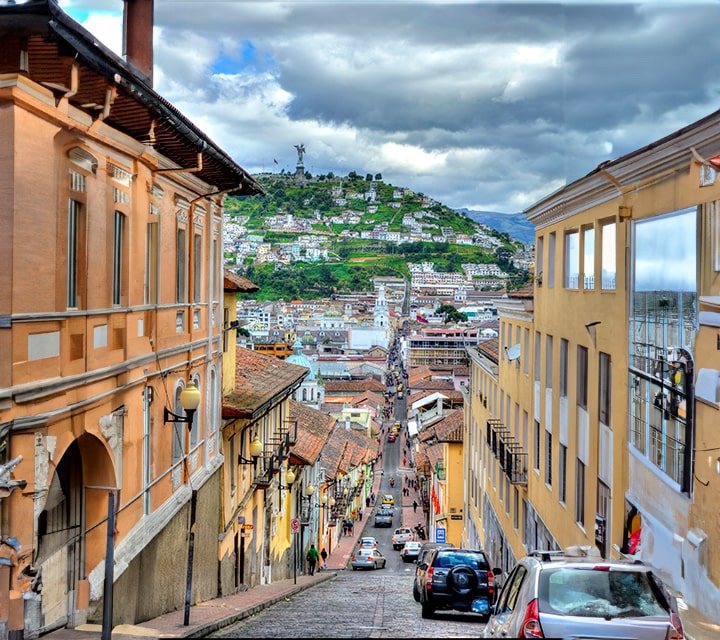
Colonial Quito is generally safe to walk around in during the day, and because the area isn’t huge, a walking tour with a competent guide is the safest way to experience the area and tends not to be expensive. If you want to walk around on your own, check with the concierge at your hotel as to where to go and places to visit, as well as those to avoid. As a precaution it’s best to leave valuables including your passport and extra credit cards in a lock box in your hotel and carry a copy of your passport and only the cash and cards you plan to use with you. As with any big city, take care not to advertise your belongings like your cell phone or expensive camera and remain aware of your surroundings.
Because of its elevation, Quito can easily get down into the mid 40s °F (8°C) at night year-round, so you won’t find many people out and about dining and drinking outside at night. Therefore, we don’t recommend walking around any part of Quito at night and instead take Uber or registered taxis (see the section on taxis below) between hotels and restaurants.
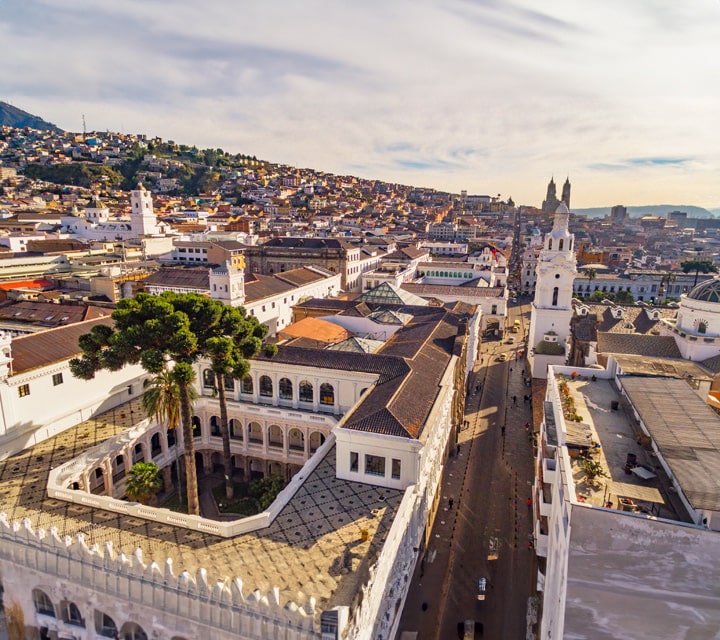
You can avoid going into the city of Quito altogether simply by staying in the Andean countryside by the airport north of the city where you will find modern hotels, and even a traditional hacienda with its own nature reserve just minutes from the airport. These locations provide excellent access to other nearby destinations you might want to visit including the Otavalo highlands, Antisana nature reserve and Papallacta hot springs and spa. Quito airport is just a 40-minute flight from the Ecuadorian Amazon, offering some of the best lodges and habitat in the basin.
These places and the countryside surrounding them tend to be very safe, but we still recommend tours over trying to see them on your own by renting a car. Drivers in Ecuador have a different sense of space and timing than do drivers in North America and you probably don’t want to have to deal with a fender bender in South America. Hiring a driver means you won’t have to worry about where it’s safe to drive, or park your car or what you will leave in it. If you do decide to drive, get a clear idea of where you are going and get a 24/7 support number in case you need help.
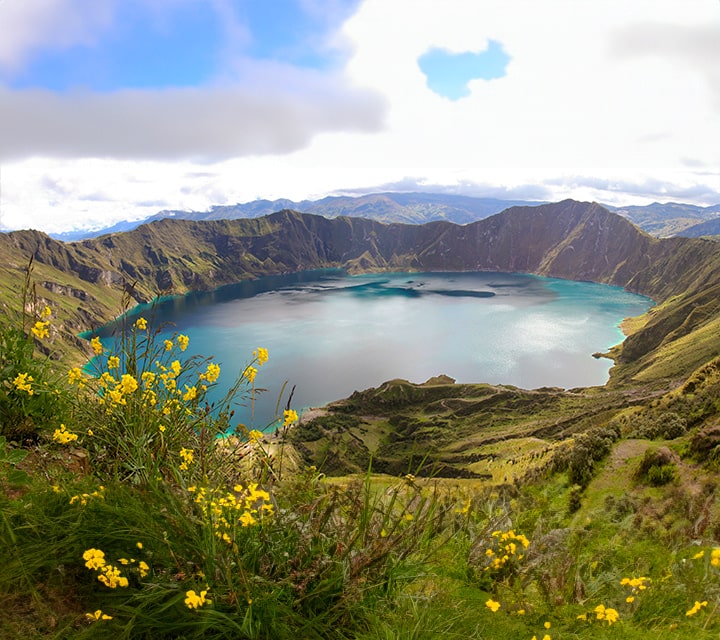
IMPORTANT NOTE ON TRANSFERS & CABS: For personal safety and convenience we recommend letting a tour company arrange all your transfers in Ecuador. However, if you find yourself in a position of needing to arrange a transfer or ride using a cab it’s important to follow some dos and don'ts to ensure your personal safety:
• Do: When arranging taxi cabs at the airport always do so using the official taxi stand counters located in front of the international and national arrivals area.
• Don't accept rides directly from a driver soliciting your business at the airport or anywhere else.
• Do: Always arrange for the front desk of your hotel or restaurant to arrange taxis using the established companies they work with. Verify your taxi with the hotel before entering the vehicle.
• Don't get rides from taxis by stopping them on the street.
Uber and Cabify are now available in Quito, Guayaquil, and Cuenca and have become popular with residents.
Note: A possibility for those concerned about altitude is that one can rent the use of a portable oxygen machine at reasonable rates in Quito. That said, very few travelers have a problem at 9,000 ft and it’s usually when going higher to 11,000 ft or more that the first symptoms of altitude sickness including headache and nausea manifest.
Guayaquil
Ecuador’s largest city is located along the river of the same name near the country’s southwest coast. While there are some attractive sections, like the colorful Santa Ana Hill neighborhood, or the riverwalk known as the Malecon 2000, the city is more of a big port town than a tourist destination. Due to its recent high crime rate related to drug violence the US State Department has posted both “reconsider” and “do not travel” warnings for Guayaquil city tours and a number of mainly coastal areas.
Even so, if you need to avoid elevations of 9,000 ft, and therefore can’t stay in Quito due to a respiratory condition or a propensity for altitude sickness, Guayaquil is your best option to fly in and out of internationally so long as you follow some simple rules:
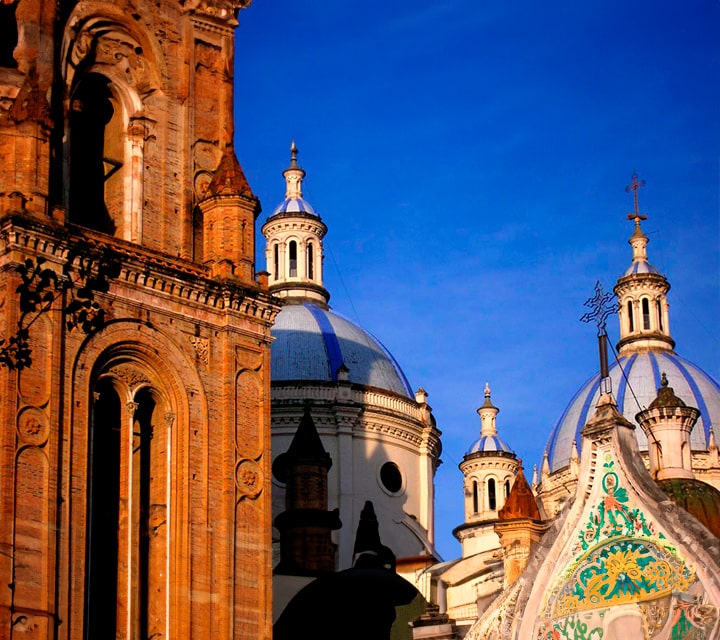
✔ Stay in a well-known hotel near the airport (not in the heart of the city). There’s even a Holiday Inn right in the airport.
✔ Either arrange private transfers or work with a hotel that offers reliable transfer shuttles.
✔ Do not tour the city or region currently and continue to check State Department advisories.
It’s best when staying in Guayaquil to book your hotels and transfers with a tour company that knows the area well, including the safest hotels and areas to stay in.
Note: There’s a big difference between staying in Guayaquil and passing through its airport or connecting to flights to other destinations. To get to and from Galapagos you may do a quick stopover at Guayaquil airport on the way from or to Quito, which is perfectly safe. You may also want to catch connecting flights to Peru or homeward in Guayaquil, which is also very safe.
The Galapagos Islands
What about sharks? That’s the question my son Alex asked when he was about to go snorkeling for the first time in the islands at age six. I handed him an underwater camera and told him he was in charge of underwater photos, and we jumped in. The first thing he said when he came up for air was, “Dad, it looks like heaven down there!” You can’t make that stuff up. Fears of sharks quickly faded as he marveled at the amazing underwater world of the Galapagos Islands.
Since accounts of shark attacks were first recorded in 1854, there have only been a total of eight incidents of shark-related aggression in the Galapagos Islands. Only three involved tourists and most were fishermen, one who fell in with his catch and another who was cleaning fish in the ocean. To date, there have been zero fatalities.
Most travelers find the Galapagos one the most welcoming, safest, and truly enchanted places on earth, largely because of the resident animal species that present little or no threat to humans as they go about their business, largely unconcerned by your presence; that is unless they are a sea lion or dolphin performing acrobatics for the visitors.
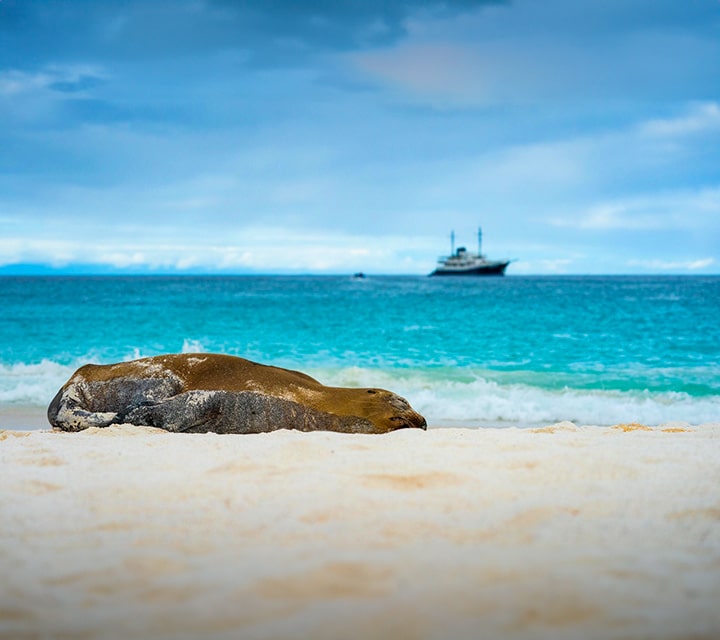
That said, paying attention and a good dose of common sense will go a long way to ensuring your safety. If you plan to spend more than one day in the Galapagos, you will need to take a vessel to get into the Galapagos National Park to visit its many landing and snorkeling sites. No matter if you are staying on a liveaboard cruise vessel or traveling via day boat, it’s important to pay attention to the safety briefing given by the captain or crew so you know what to do if there’s an emergency. These aren’t the same briefings you’ve sat through countless times before a flight. You’ll want to know what to do if someone goes overboard, which happens rarely, or simply who to take commands from should you need to report to a certain location or don life vests. It’s just as important to pay attention to briefings given by your guides on topics like snorkeling.
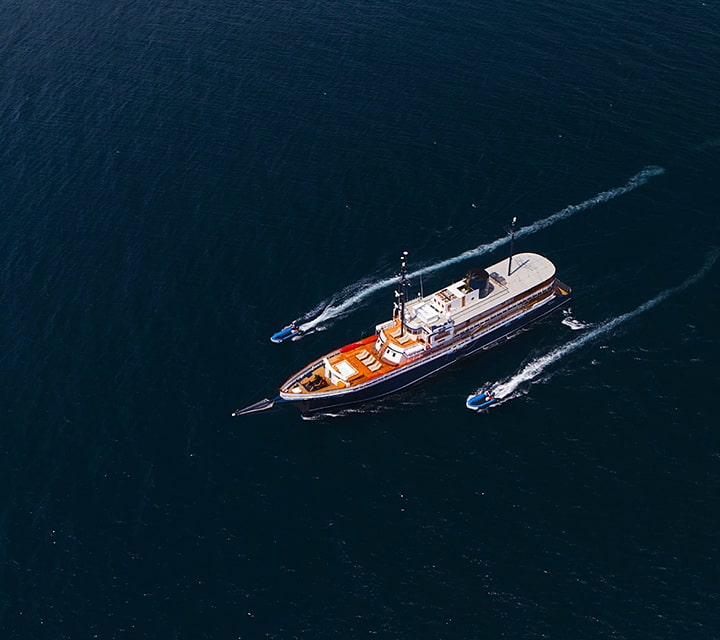
The Galapagos has roughly 30,000 inhabitants spread between 4 port towns. Crime is virtually non-existent here. Cruise travelers may spend a day in the port towns, if that, in the company of guides, and the rest of their time will be spent in the National Park surrounded by wildlife. Land-based visitors staying in hotels will largely be relegated to the port towns, having to take day boats to access the park.
Marine safety is the top priority for all companies operating in the Galapagos. Competent vessel owners carry all the required safety measures on board and cruise companies carry life vests for all passengers and crew, that one wears daily every time you board one of the rigid inflatable boats (RIB) to visit a landing or snorkeling site. RIBs are considered perhaps the safest type of vessel for any boating adventure and can be quickly deployed in an emergency. One is never that far from other vessels or land in Galapagos.
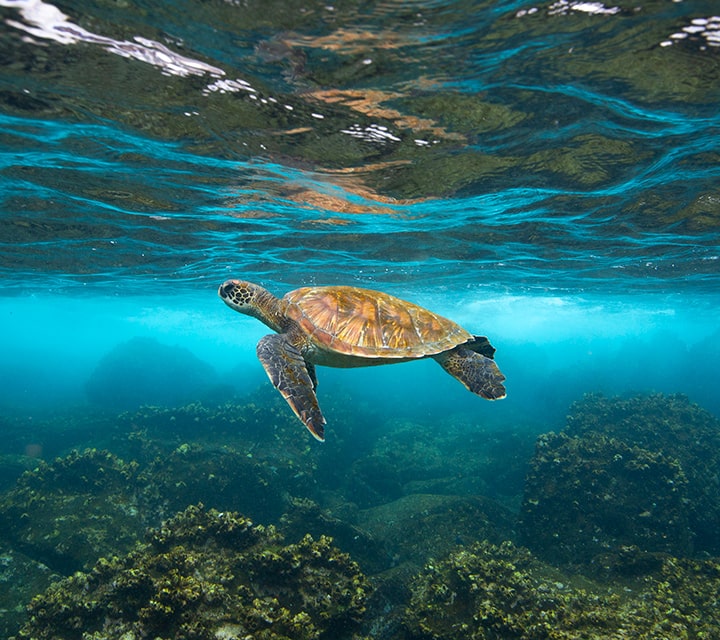
The exception occurred in the Fall of 2022 when the interisland ferry, Angy, sank and capsized resulting in 4 fatalities. The term “interisland ferry” is really misleading, because these are small, cabin cruiser sized boats with multiple outboard motors designed for speed, not stability. These “ferries”, also called fast boats, are used to get between Galapagos ports, usually by travelers on a budget doing hotel-based stays. If you have to take one check on all the safety features first and do the same for day boats that take passengers into the park from the hotels.
These boats are a far cry from the larger and more seaworthy liveaboard cruise vessels equipped with RIBs and all the amenities including safety features. There also aren’t any Galapagos guides aboard the fast boat ferries as there are on day boats and liveaboards.
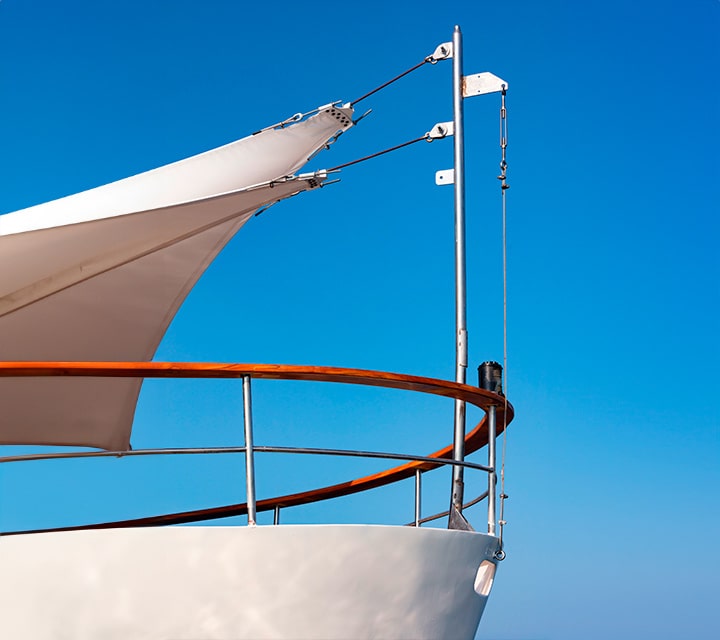
No traveler is permitted to set foot in the Galapagos National Park, comprising 93% of the islands and all the marine area, unless in the presence of a National Park Guide. Galapagos guides tend to be knowledgeable, fun and entertaining; they also know how to keep you safe, which is an important aspect of their job. When your guide tells you not to swim towards a colony of sea lions and instead wait for the younger sea lions to come to you, listen. The only person I know who was bitten by a sea lion in over 25 years was a guest who ignored that advice and swam directly towards a colony guarded by a large bull. Fortunately, the beach master only nipped his wet suit and didn’t break the skin, all of which could have been avoided by listening to one’s guide.
In many ways you get what you pay for in the Galapagos including safety in the form of better, safer yachts and ships, more competent crews and captains and top-notch guides looking out for you.


